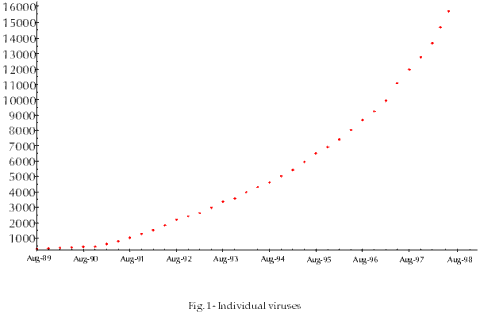
Dr. Jan Hruska, Sophos Plc
October 1998
Computer viruses continue to be one of the principal headaches for today's increasingly interconnected corporations. This paper will look at virus history, outline the present state of affairs, discuss the ingredients of a successful defence strategy and consider how the problem is likely to develop in the future.
The history of computer viruses is relatively brief. After the first theoretical paper on the subject by Prof. Fred Cohen, published in 1984, it did not take long for the first virus to appear in the wild. In 1986 the Brain virus (written by the Alvi brothers in Lahore, Pakistan) caused relatively few infections, but gave everybody the taste of things to come. After a few more viruses appeared in 1987, the first anti-virus software was published and the new anti-virus industry was born. Relatively few of the early anti-virus companies are still around today.
The virus writers continued producing new viruses and inventing new concepts: encryption, polymorphism, stealth, tunnelling, sparse infections, cavity infections, anti-debugging tricks etc. Interestingly enough, some of these 'advanced' concepts were tried very early on: Brain was a stealth virus, while Cascade was encrypted (though not polymorphic). Anti-virus software producers combated all these techniques retroactively, but successfully. The search for the ultimate undetectable virus by the virus-writing community has so far been unsuccessful.
From the early days the virus writers tried to make virus writing as easy as possible (presumably to attract more followers). In 1992 the first virus construction kits appeared which enabled anybody who could point and click with the mouse to create a virus to their specifications. A succession of such kits followed.
1992 was also the year of the great Michelangelo scare, mainly fuelled by the media and one or two of the less timid members of the anti-virus community: Michelangelo was predicted to erase the hard disks of 'millions' of PCs on 6th March 1992. On the day it turned out to be a non-event: the worldwide number of virus infections which triggered was probably in thousands rather than millions.
Since the early days the virus writers have been trying to cause as many headaches as possible for the anti-virus companies. Knowing full well that polymorphic (i.e. self-mutating and encrypted) viruses are much more difficult to detect than non-polymorphic ones, they put their energies into creating them. Fortunately, writing polymorphic viruses is much more difficult than writing non-polymorphic ones and often produces viruses which do not replicate well. Virus writers once again tried to make polymorphic virus creation as easy as possible and released a succession of 'polymorphic toolkits', starting with the Dark Avenger's Mutation Engine.
It was well known even in the early virus days that viruses written in macro languages were possible, providing that the language supported the constructs necessary to enable the replication of code to be written. It took the virus-writing community a relatively long time to produce the first macro virus. Winword/Conceptappeared in August 1995 and was written in Microsoft WordBasic. Suddenly the world was faced with the need to virus-scan yet another set of objects, and an increasingly large set at that. It did not take long for the first Microsoft Excel virus to appear and it is now only a matter of time before viruses which infect other components of Office 97 (such as PowerPoint) are written.
The first Windows 95 virus was written in 1995 (W95/Boza) by the Australian virus-writing group VLAD. This stirred up the media. W95/Boza was badly written, did not replicate most of the time and stood absolutely no chance of becoming widespread. However, it was the first 'proof of concept' that viruses could be written for Windows 95.
In 1997 the first Office 97 virus appeared, capable of cross-infecting Office 97 application objects.
1998 was relatively rich in virus events: a virus capable of infecting Microsoft Access databases was discovered (AM97/Accessiv); a Java virus which can infect Java applications (but not applets) was written (Strange Brew); a virus capable of physically damaging computer hardware was widely distributed (CIH). While the former two events were interesting from the 'being first' point of view, neither are significant in any practical sense. CIH unfortunately is: more about that later.
Over 16000 viruses currently exist (August 1998, Fig. 1). Most of these are parasitic viruses (aka file or program viruses), accounting for 79% of the total, about 8% are pure boot sector viruses, 7% are multipartite viruses (infecting both boot sectors and programs) and 6% are macro viruses (Fig. 2). Parasitic viruses are currently responsible for only 3% of all infections, multipartite viruses for 6%, macro viruses for 46% and boot sector viruses for 45% (Fig. 3). The most commonly encountered virus is Winword/Cap, responsible for about 15% of all infections reported to Sophos* between January and June 1998 (Fig. 4). The second most common virus is Excel/Laroux, responsible for about 10% of infections over the same period.
The number of individual viruses continues to grow. While most of them are either mutations or imitations of existing viruses, genuinely new viruses continue to appear.

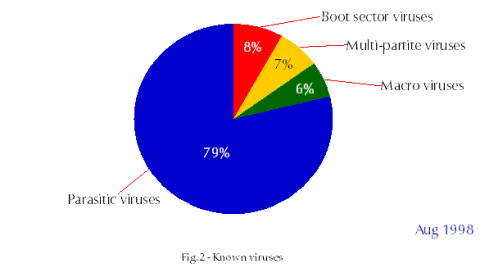
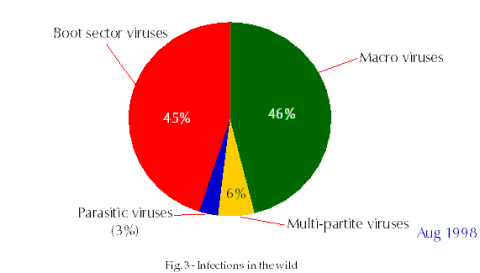
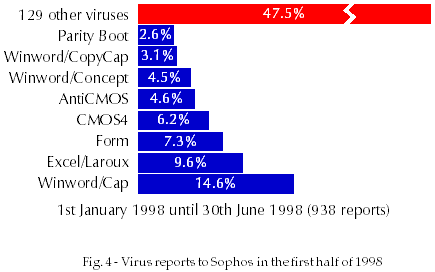
The virus-writing community is waging an ongoing war against PC users and the recent CIH virus is a clear sign that their efforts have reached a dangerous new dimension. In the early days, virus side-effects were in some cases laughed at and in most others taken as a relatively minor pain in the neck. After all, most of them could be remedied relatively easily: infected executables could be restored from backups, disks could be disinfected or reformatted, documents could be disinfected or restored from backups. When data-corrupting viruses appeared, users, interestingly, did not take much notice until viruses such as Winword/Wazzu started interfering with their documents (consider the effects of changing a contract clause from 'The party shall not be obliged...' to 'The party shall be obliged...'). Another example is the recent data-diddling Laroux variant. The seriousness of the side-effects reached a new peak when CIH appeared: this was the first virus which damages hardware (as well as erasing information on the hard disk), requiring the physical replacement of the BIOS chip. Admittedly, for technical reasons it does not do this on every PC, but since it is a potential danger for a significant number of PCs, it should be treated as something very serious.
The ease with which information flows between organisations today is a significant contributor to the increase in virus spread. This is not only true of the passive spread of viruses (A inadvertently sends a virus-infected document to B), but also for the active spread (A intentionally sends a virus-infected document to B or, more commonly, A gets a virus collection from one of the many virus-exchange sites on the web).
The Internet has given the virus-writing community a vastly improved means of keeping in touch compared with the 'old style' virus exchange (VX) bulletin boards. VX BBSes had to have a telephone number, which implied a real threat from law enforcement agencies. The number could be traced to a physical address, the equipment could be seized and the perpetrators (sometimes) prosecuted. The Internet offers much more scope for anonymity and protection against the forces of law. In fact, it would be surprising if the UK's Computer Misuse Act was successfully applied again in a prosecution of a virus-related case: such is the ease with which the virus authors can hide. A number of USENET groups exist which offer active discussion forums for virus writers (and others), such as alt.comp.virus, alt.comp.virus.source.code etc. Web sites with virus collections and virus-writing materials keep appearing faster than responsible Internet service providers manage to close them down: at a guess there are currently some 200 virus-related sites worldwide, of which some 10% could be classed as active.
Virus spread has been further helped by a recurrence of the problem which used to plague magazines in the early 1990s: including infected floppy disks on the magazine cover. Nowadays the magazines are supplying cover CDs with thousands of programs, which, once decompressed, often contain up to 2 Gb of material. In 1998 there have been at least ten documented cases of tens or hundreds of thousands of infected CDs being shipped. Denying that an infected CD has actually been shipped is, of course, much more difficult than doing the same thing for floppy disks. Some magazines have adopted an apologetic attitude after supplying the readership with infected CDs, while others have refused to withdraw the magazine from sale on the grounds of cost (in one case when there was a CD infected with CIH!). Any virus achieves a critical mass by such mass distribution and has, of course, a very good chance of spreading far and wide. Unfortunately it is difficult to see how the situation is going to improve if magazines continue to ship CDs (which they will): proving that any piece of software which is written and compiled by a third party is virus-free is practically impossible in the same way that it is practically impossible to prove that the software is free from bugs (of the programming kind). There is no easy solution to this and one can only advocate extreme caution about using any software supplied on magazine cover CDs.
The increasing virus numbers are a minor headache for anti-virus software users. They notice that the anti-virus software is getting bigger and bigger and takes longer and longer to run (although the latter is somewhat compensated for by the never-ending quest for faster computers).
The increasing virus numbers are a major headache for anti-virus companies, who have to invest heavily in continuous research activity. Many try minimising the pain: some swallow or allow themselves to be swallowed by competitors in order to increase market share while halving research efforts (e.g. American company Network Associates taking over the British company Dr. Solomon's in August 1998). Other anti-virus companies are combining research efforts by using virus research obtained from several sources (e.g. Finnish Data Fellows using the Icelandic FPROT engine with the Russian AVP). Others have simply got out of the anti-virus field (e.g. IBM and Intel abandoning their anti-virus products and allying with Symantec).
This trend is likely to continue as viruses become more numerous, the number of types of object that they infect increases and virus search engines become more complicated. In the end there may well be only two or three world-class companies whose revenues will be able to finance the ongoing research effort required to maintain an effective anti-virus product.
Far too many boot sector virus infections are still reported. There is really no excuse for getting infected by a pure boot sector virus. Since the early 1990s most manufacturers have been shipping PCs which allow the user to switch the default boot sequence from floppy drive followed by hard drive to hard drive followed by floppy drive. This makes the PC immune to pure boot sector viruses. Almost 50% of virus infections today could be prevented by this simple operation which takes less than a minute to complete. Sadly, the high percentage of boot sector virus infections today is evidence that this technique continues to be ignored.
A program which would set the safe boot sequence automatically (for example from a login script) is technically possible, but the way of storing the sequence information in the CMOS is not standard and depends on the BIOS manufacturer. This makes an automated approach difficult. New operating systems (Windows 95, Windows NT and OS/2) complicate things further by prohibiting direct port access. The easiest solution is still to visit each PC physically.
If the manufacturers have provided the ability to set the boot sequence, why is the default sequence not the reverse of the current one? There is no good logical explanation.
On-demand anti-virus software which can be used to check disks or files has limited use in a multi-PC environment connected to the outside world where there are so many easy and quick ways of introducing potentially infected objects into the trusted domain. The two main anti-virus techniques are successfully applied in such environments: virus-checking gateways and on-access virus scanning.
Virus-checking gateways (Fig. 5) intercept email coming into the organisation, detaching the attachments, unpacking any encoded parts and sending them to the virus scanner. Infected objects are discarded or disinfected, while uninfected ones are passed through to the recipient.
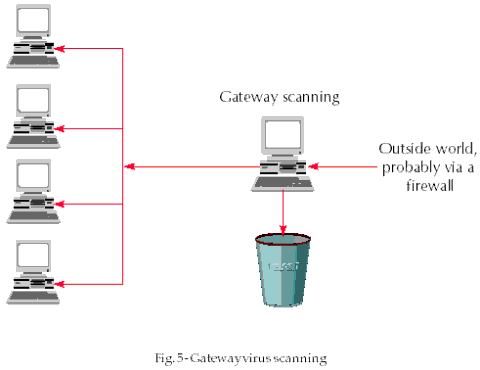
When considering the use of a virus-checking gateway, one should watch out for the implications of the multitude of encoding standards as well as throughput performance.
Encoding standards
There are numerous 'standards' for Internet mail attachments which convert binary information into 7-bit ASCII text in order to ensure their unaltered passage across the network via SMTP. This typically makes files bigger, so they are often compressed before conversion, using numerous available compression methods. The gateway can only verify attachments that are compressed and encoded using the algorithms it knows about. Furthermore, binary files can be manually encoded into printable text (e.g. UUENCODE) or encrypted (e.g. PGP) and included into the message. The gateway needs to recognise these parts, decode or decrypt them and check them. The problem is very complex (and practically impossible for encrypted files) and no available gateway can (or claims to) unpack all objects completely.
Throughput performance
Gateway scanners (or, more precisely, gateway unpackers) normally invoke (third-party) virus scanners for checking of unpacked objects. A scanner needs to initialise its database every time it is run, which can take several seconds. This can have a large impact on the throughput performance of the gateway, which is best solved by using a program-level interface between the gateway and the scanner (such as Sophos' SAVI). Up to thirty-fold increases in performance over the conventional approach can be obtained.
The use of a gateway must be supplemented by other anti-virus techniques since a gateway alone cannot detect viruses in carriers such as floppy disks, CDs etc. which are widely used. After all, it was a CD which spawned the Winword/Concept distribution.
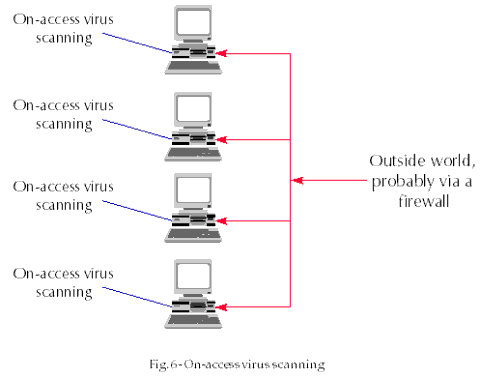
On-access scanning provides virus detection at the workstation. On-access scanners normally intercept file open and file close operations**, virus checking the file and allowing the file access or execution to proceed only if no viruses are found. The questions of how a file is packed, whether it is compressed or encrypted, or where it comes from, become irrelevant: the virus will be caught on unpacking, decompression or decryption. If the file is, for example, compressed with ZIP, unZIPping it will cause every executable item to be checked as it is created and, if a virus is found, the on-access scanner will prevent access to the offending item.
Since Windows 3, Windows 95 and Windows NT are not hampered by DOS's 640K memory limit, on-access virus scanning has become a feasible and practical option. The scanner is a VxD (Virtual Device Driver for Windows 3 and Windows 95) or an FSFD (File System Filter Driver for Windows NT).
On-access virus scanning is a powerful technique which depends on scanning to detect viruses. Scanners have to be updated as new viruses appear and no on-access virus scanner will catch a virus that it does not recognise as such. The burden of scanner updating is still present and unlikely to disappear in the future, although good anti-virus software usually provides an automated way of distributing updates in networked environments.
If the disaster does happen and the virus manages to evade all defences and land on the desktops, you want to minimise the hardware damage it can cause.
We are likely to see more CIH style viruses in the future and it has never been more important than now to prevent damage which requires physical repair of the infected PCs. If the motherboards used in your PCs have a Flash BIOS (which is reprogrammable by the motherboard itself), the motherboards should also have a working hardware switchable write-enable jumper (or switch). Beware: some motherboards have a jumper which does not actually work. There is considerable variation in the layout, labelling and functionality of Flash BIOS amongst motherboards and advice should be sought from the board manufacturer.
The following are just some of the events which are likely to happen:
The pace at which new viruses are being created is increasing. When choosing an anti-virus partner (and it is increasingly necessary to look for a partner rather than just a supplier) make sure that they have the technical and financial resources as well as the will to stay in the front line of the battle against viruses.
Both of these active components of the www world have (quite different) security mechanisms in place which are supposed to prevent virus spread.
Java has two main potential weak spots:
The security of ActiveX relies on only authenticated code being allowed to run. This is better than nothing, but it leaves a lot to be desired. It is also too easily overridden by the user (i.e. not preventable by the system administrator) in current Microsoft implementations.
The demand for bandwidth is increasing all the time, with more and more information being exchanged more and more rapidly. The danger of viruses increases with the rate of object exchange, which suggests a more dangerous future.
The trend towards incorporating increasingly powerful application macro languages is common. The software manufacturers reason that supplying the macro capability makes applications more flexible, customisable and easy to use: this is true. Unfortunately, it also makes them less virus-proof.
Another trend which is present is the standardisation of macro-languages: Microsoft achieved this within Office 97, with most member applications capable of using the powerful Visual Basic for Applications (VBA5). If this trend continues (as it looks likely to), in the future viruses may well be presented with only one universal environment instead of several incompatible ones. Virus writers must be rubbing their hands...
The CIH source code (including its Flash damaging routine) is widely available on the net, so it is only a matter of time before similar destructive routines appear in other viruses.
The virus problem is getting worse. Increasing pressures to connect to the outside world, exchange information and do it all rapidly, decreases the control over what is exchanged and increases the potential for malicious code to penetrate even the best protected environments. The virus-writing underworld seems determined to cause as much trouble as they can and are using the Internet to its maximum potential to help them spread the word while not exposing themselves to any dangers of being caught. Anti-virus companies are finding it more and more difficult to keep up the research effort and in the last year some have consolidated or abandoned their efforts.
The future is not rosy, but given sufficient determination and resources to crack the virus problem, it should be possible to do it.
* Virus statistics are based on viruses reported to Sophos. An incident is logged as one unit regardless of whether the virus was intercepted before causing an infection or whether it infected one PC or 1000 PCs. Other anti-virus vendors report similar percentages.
** In practice, a few more things are checked.